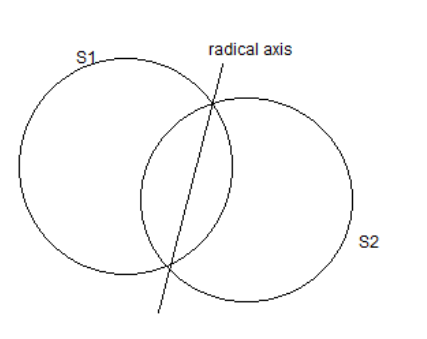
If P and Q are the points of intersection of the circles ${x^2} + {y^2} + 3x + 7y + 2p - 5 = 0{\text{ and }}{x^2} + {y^2} + 2x + 2y - {p^2} = 0$, then there is a circle passing through P, Q and (1, 1) for
$
{\text{A}}{\text{. all values of p}}{\text{.}} \\
{\text{B}}{\text{. all except one value of p}}{\text{.}} \\
{\text{C}}{\text{. all except two values of p}}{\text{.}} \\
{\text{D}}{\text{. exactly one value of p}}{\text{.}} \\
$
Answer
575.4k+ views
Hint: Find the radical axis of the two circles. Then use the family of circles concept to get the circle passing through the two intersection points and the radical axis. After that, check the condition for (1, 1) to lie on the circle.
Complete step-by-step answer:
The circles given are:
$
{S_1}:{x^2} + {y^2} + 3x + 7y + 2p - 5 = 0 \\
{S_2}:{x^2} + {y^2} + 2x + 2y - {p^2} = 0 \\
$
The common chord passing through the intersection of the two circles is termed as the radical axis.
So, the radical axis is determined by: ${S_1} - {S_2} = 0$
Here,
$
{S_1} - {S_2} \\
= {x^2} + {y^2} + 3x + 7y + 2p - 5 - ({x^2} + {y^2} + 2x + 2y - {p^2}) = 0 \\
= x + 5y + 2p - 5 + {p^2} = 0 \\
$
The radical axis is also in terms of p.
Now, the circle passing through the radical axis and the point of intersection of the two circles would be given by-
${S_1} + \lambda L = 0$
${S_3}:{x^2} + {y^2} + 3x + 7y + 2p - 5 + \lambda \left( {x + 5y + 2p - 5 + {p^2}} \right) = 0$ For this circle to pass through (1, 1) the point must lie on it, so substitute x=1 and y=1 in the circle equation:
$
\Rightarrow {1^2} + {1^2} + 3\left( 1 \right) + 7\left( 1 \right) + 2p - 5 + \lambda \left( {\left( 1 \right) + 5\left( 1 \right) + 2p - 5 + {p^2}} \right) = 0 \\
\Rightarrow 7 + 2p + \lambda \left( {1 + 2p + {p^2}} \right) = 0 \\
\Rightarrow \lambda = \dfrac{{ - (7 + 2p)}}{{\left( {1 + 2p + {p^2}} \right)}} \\
$
For $\lambda $ to exist, p should not get the value-
$
1 + 2p + {p^2} \ne 0 \\
{\left( {p + 1} \right)^2} \ne 0 \\
p \ne - 1 \\
$
Thus p takes all values except -1.
The correct option is B.
Note: The radical axis is the common chord of the two circles which passes through their intersection points. This is why, while finding the circle passing through the two intersecting points, we took the radical axis into consideration.

Complete step-by-step answer:
The circles given are:
$
{S_1}:{x^2} + {y^2} + 3x + 7y + 2p - 5 = 0 \\
{S_2}:{x^2} + {y^2} + 2x + 2y - {p^2} = 0 \\
$
The common chord passing through the intersection of the two circles is termed as the radical axis.
So, the radical axis is determined by: ${S_1} - {S_2} = 0$
Here,
$
{S_1} - {S_2} \\
= {x^2} + {y^2} + 3x + 7y + 2p - 5 - ({x^2} + {y^2} + 2x + 2y - {p^2}) = 0 \\
= x + 5y + 2p - 5 + {p^2} = 0 \\
$
The radical axis is also in terms of p.
Now, the circle passing through the radical axis and the point of intersection of the two circles would be given by-
${S_1} + \lambda L = 0$
${S_3}:{x^2} + {y^2} + 3x + 7y + 2p - 5 + \lambda \left( {x + 5y + 2p - 5 + {p^2}} \right) = 0$ For this circle to pass through (1, 1) the point must lie on it, so substitute x=1 and y=1 in the circle equation:
$
\Rightarrow {1^2} + {1^2} + 3\left( 1 \right) + 7\left( 1 \right) + 2p - 5 + \lambda \left( {\left( 1 \right) + 5\left( 1 \right) + 2p - 5 + {p^2}} \right) = 0 \\
\Rightarrow 7 + 2p + \lambda \left( {1 + 2p + {p^2}} \right) = 0 \\
\Rightarrow \lambda = \dfrac{{ - (7 + 2p)}}{{\left( {1 + 2p + {p^2}} \right)}} \\
$
For $\lambda $ to exist, p should not get the value-
$
1 + 2p + {p^2} \ne 0 \\
{\left( {p + 1} \right)^2} \ne 0 \\
p \ne - 1 \\
$
Thus p takes all values except -1.
The correct option is B.
Note: The radical axis is the common chord of the two circles which passes through their intersection points. This is why, while finding the circle passing through the two intersecting points, we took the radical axis into consideration.

Recently Updated Pages
Master Class 12 Business Studies: Engaging Questions & Answers for Success

Master Class 12 Economics: Engaging Questions & Answers for Success

Master Class 12 English: Engaging Questions & Answers for Success

Master Class 12 Maths: Engaging Questions & Answers for Success

Master Class 12 Social Science: Engaging Questions & Answers for Success

Master Class 12 Chemistry: Engaging Questions & Answers for Success

Trending doubts
What are the major means of transport Explain each class 12 social science CBSE

Which are the Top 10 Largest Countries of the World?

Draw a labelled sketch of the human eye class 12 physics CBSE

How much time does it take to bleed after eating p class 12 biology CBSE

Explain sex determination in humans with line diag class 12 biology CBSE

Differentiate between homogeneous and heterogeneous class 12 chemistry CBSE




